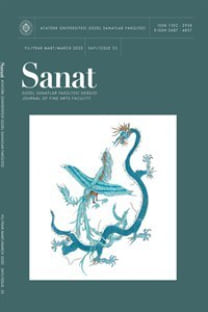Adolphe Appia Öncesi ve Sonrası Sahne Sanatlarında Işık, Gölge ve Karanlık Kullanımı
Adolphe Appia, karanlık, ışık, gölge, tiyatro
The Use of Light, Shadow, and Darkness in the Performance Arts Before and After Adolphe Appia
Adolphe Appia, darkness, light, shadow, theater,
___
- Bellman, W. (1974). Görüntüleri birleştirme ve bu görselleri ışık, gölge ve karanlıkla sahneleme [Performans]. Lighting the stage. (s. 280) içinde. Chandler.
- Bellman, W. (1974). Renk gölgeleri ve farklı karanlık düzeyleri [Performans]. Lighting the stage. (s. 280) içinde. Chandler.
- Bellman, W. (1974). Verdi Operası [Performans]. Lighting the stage. (s. 360) içinde. Chandler.
- Bellman, W. (1974). Işık, gölge ve karanlığı kullanarak görselleştirmeler ve illüzyonlar [Performans]. Lighting the stage. (s. 295) içinde. Chandler.
- Bellman, W. (1974). Lighting the stage. Chandler Publications.
- Bentlye, E. (1968). The theory of the modern stage: An introduction to modern theatre and drama. Penguin Books.
- Brockett, O. (1996). History of the theatre H. Azadivar (Çev.). Morvarid.
- Çamurdan, E. (1996). Çağdaş tiyatro ve dramaturgi. Mitos Boyut.
- Durant, W. (2007). The history of theatre according to Will Durant A. Shadravan (Çev.). Scientific and Cultural.
- Evans, R. (1997). Experimental theatre from Stanislavsky to Peter Brook M. Eslamiyeh (Çev.) Sorosh.
- Fuat, M. (2010). Tiyatro tarihi. Mitos-Boyut.
- Jahanparvar, Z. (1995). A study of the works of Adolphe Appia. University of Arts.
- Keller, M. (1999). Ritmik boşluk başlıklı Appia Sahnesi’nin tasarımının bir örneği. [Sahne Tasarımı]. Light fantastic & the art and desgin of lighting. (s. 158) içinde. Prestel.
- Keller, M. (1999). Parsifal opera sahne tasarımı [Sahne Tasarımı]. Light fantastic & the art and desgin of lighting. (s. 160) içinde. Prestel.
- Keller, M. (1999). The Gold Rhine Operası sahnesinin tasarımı [Sahne Tasarımı]. Light fantastic & the art and desgin of lighting. (s. 160) içinde. Prestel.
- Keller, M. (1999). Light fantastic & the art and desgin of lighting (s. 49). Prestel.
- Kermani, F. N. (1988). Leading theatre, experimental and absurd. University Jahad.
- Kermani, F. N. (1989). Symbolism in the dramatic literature. Barg.
- Parker, W. (1968). Scane desing and stage lighting. Holt, Rinehart and Winston.
- Pilbrow, R. (1979). Stage lighting. Cassell Ltd.
- Saburi Kashaninejad, P. (1971). Max Reinhardt and Adolphe Appia. University of Arts.
- Shamhiri, A. (1987). Lighting in the theatre. University Jahad.
- Simonson, L. (1964). The stage is set (s. 15). Theatre Art Books.
- Simonson, L. (1999). New scene theory Y. A. Abbsi (Çev.). Show Magazine.
- Svoboda, J. (2000). Secret of theatrical space cloth: J. M. Burian. Applause Books.
- Svoboda, J. (2000). İki aktör ile iki sandalyeyi canlandırmak [Performans]. Secret of theatrical space cloth: J. M. Burian. (s. 180) içinde. Applause Books.
- ISSN: 1302-2938
- Başlangıç: 2020
- Yayıncı: Atatürk Üniversitesi
Erzurum’daki Tarihî Yapılarda Astronominin İzleri
Ahmet POLATOĞLU, Selahattin POLATOĞLU, Ömer Faruk AKBAŞ
Minimalist Sanat Anlayışı Çerçevesinde Hayvan Hakları Konulu Afişler
Adolphe Appia Öncesi ve Sonrası Sahne Sanatlarında Işık, Gölge ve Karanlık Kullanımı
Sürdürülebilir Moda Tasarımı ve Çanta Tasarım Örneği
Muazzez ÇETİNER, Naile Rengin Oyman RENGİN OYMAN
Theodoros Metokhites ve Khora Manastırı Kilisesi (Kariye Camii)
Münir Nurettin Selçuk Eserlerinin Makam, Form, Usûl ve Güftekâr Tasnifi
Konservatuvar Öğrencilerinin Empatik Öfke Düzeylerinin Çeşitli Değişkenlere Göre İncelenmesi
